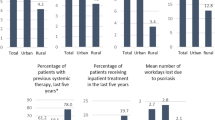Abstract
This paper describes work in collaboration with a large dermatology directorate in South Wales to map out current patient flow and activity levels for psoriasis management. Psoriasis is a chronic skin disease that often has a high impact on patient quality of life. Clinical services for patients with moderate to severe psoriasis tend to be located in secondary care hospitals. The range of services that were studied, their geographical location in relation to the distribution of population, and the population demographics in this health board were not unique; similar profiles for these factors can be found throughout the NHS in England and Wales. The model was created to analyse patient flow through different therapies, with the aim of maximising throughput of patients, eliminating bottlenecks, improving patient access to services and improving patient safety. It was shown that reducing waiting times and improving access to phototherapy would lower overall service costs, as fewer patients would subsequently require systemic and biologic therapies. The model has been used to quantify how recent year-on-year increases in overall spend on psoriasis treatments might be slowed and eventually halted. This would require reallocation of notional cost-savings generated by reducing the rate of increase in the drug spend to fund the development of a more balanced and accessible network of more basic psoriasis services.



Similar content being viewed by others
References
Anstey A (2013) Patient empowerment increases capacity and widens access to phototherapy. British Journal of Dermatology 169 (2), 241–242.
Brailsford SC, Harper PR, Patel B and Pitt M (2009) An analysis of the academic literature on simulation and modelling in health care. Journal of Simulation 3 (3), 130–140.
Eedy D (2008) An Audit of the Provision of Dermatology Services in Secondary Care in the United Kingdom with A Focus on the Care of People with Psoriasis. British Association of Dermatologists and Royal College of Physicians, London.
Fone D et al (2003) Systematic review of the use and value of computer simulation modelling in population health and health care delivery. Journal of Public Health 25 (4), 325–335.
Harper PR (2002) A framework for operational modelling of hospital resources. Health Care Management Science 5 (3), 165–173.
HM Treasury (2013) Spending round 2013: Next stage in government’s plan to move from rescue to recovery. HM Treasury. [WWW document] https://www.gov.uk/government/news/spending-round-2013-next-stage-in-governments-plan-to-move-from-rescue-to-recovery (accessed 26 June 2013).
Jun JB, Jacobson SH and Swisher JR (1999) Application of discrete-event simulation in health care clinics: a survey. Journal of the Operational Research Society 50 (2), 109–123.
Katsaliaki K and Mustafee N (2011) Applications of simulation within the healthcare context. Journal of the Operational Research Society 62 (8), 1431–1451.
Kleijnen J (1995) Verification and validation of simulation models. European Journal of Operational Research 82 (1), 145–162.
Krueger G et al (2000) Two considerations for patients with psoriasis and their clinicians: what defines mild, moderate, and severe psoriasis? What constitutes a clinically significant improvement when treating psoriasis? Journal of the American Academy of Dermatology 43 (2), 281–285.
Krutman J et al (2008) Dermatological Phototherapy and Photodiagnostic Methods. Springer, New York.
National Assembly for Wales Research Note (2012) NHS Referral to Treatment Waiting Times. National Assembly for Wales Research Service, Wales.
NICE clinical guideline 153 (2012) Psoriasis: the assessment and management of psoriasis. [WWW document] http://www.nice.org.uk/guidance/cg153/resources/guidance-psoriasis-pdf (accessed October 2012).
Parisi R, Griffiths CEM and Ashcroft DM (2011) Systematic review of the incidence and prevalence of psoriasis. British Journal of Dermatology 165 (Supplement 1), e5.
Putman K (2012) Modelling psoriasis patient flow through available secondary care treatment therapies at Aneurin Bevan Health Board. M.Sc. Dissertation, Cardiff University, UK.
Welsh Government Report (2011) Waiting times for NHS services. Statistical Directorate, Welsh Government. [WWW document] http://wales.gov.uk/docs/statistics/2011/110609waitingtimesfaqen.pdf.
Yule S, Sanyal S, Ibbotson S, Moseley H and Dawe RS (2013) Self-administration of hospital-based narrowband ultraviolet B (TL-01) phototherapy; a feasibility study in an outpatient setting. British Journal of Dermatology 169, 464–468.
Author information
Authors and Affiliations
Corresponding author
Rights and permissions
About this article
Cite this article
Putman, K., Anstey, A., Harper, P. et al. Modelling of psoriasis patient flows for the reconfiguration of secondary care services and treatments. Health Syst 5, 13–20 (2016). https://doi.org/10.1057/hs.2015.4
Received:
Revised:
Accepted:
Published:
Issue Date:
DOI: https://doi.org/10.1057/hs.2015.4



